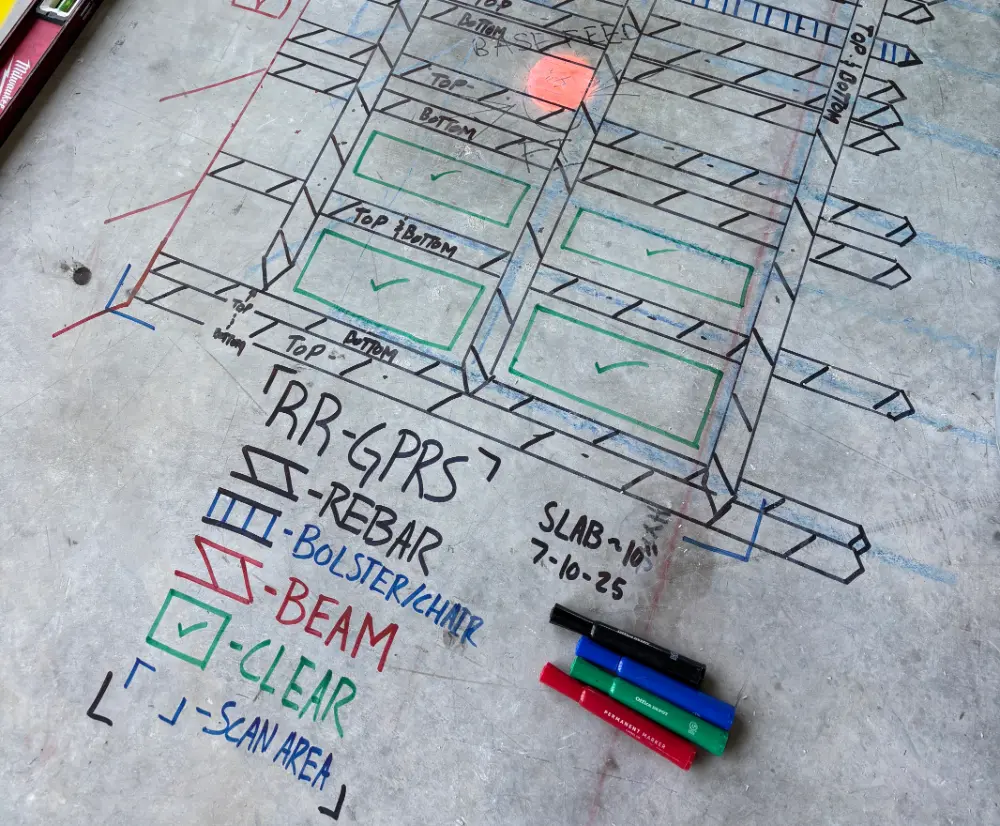A general contractor in the Dallas-Fort Worth area wasted $30,000 on two sub-par concrete scanning and imaging investigations of what they were told were post-tensioned concrete slabs inside a high-rise office building.
The building engineer on the renovation project initially required the slabs be inspected with concrete X-ray to clear safe coring locations. The X-ray company told the GC and their concrete corer that the slabs were post-tensioned – but they did not trust that information, or the data they received indicating where they could and could not safely drill into the slabs.
While concrete X-ray can be a reliable way to obtain information about infrastructure embedded within concrete slabs, GPR has proven to be the superior technology for these types of investigations.
GPR scanning is safer, faster, and cheaper than X-ray. Unlike X-ray, GPR scanners emit no harmful radiation and can visualize the infrastructure inside a slab without needing access to both sides. And GPR scanners are less bulky than X-ray and require little set-up time, meaning an investigation into your project’s slabs will not cause delays to your schedule.
But even the right technology for the job isn’t going to give you accurate results if the operator isn’t properly trained.
After the X-ray scan failed to provide accurate results, a GPR investigation of the high-rise’s slabs by a local company yielded a similar result: neither the contractor, nor the subcontractor, felt confident in coring based on the data they received.
“Between the other GPR and the X-ray company, the coring company and GC were still not confident in their markings and information provided,” said GPRS Area Manager Zack Walter.
GPRS stepped in to solve the problem, providing precision concrete scanning services that put the project back on track.
Project Manager Reynaldo Rodriguez demonstrated the accuracy of GPRS’ concrete scanning – utilizing GPR in conjunction with electromagnetic (EM) locating – to the building engineer, general contractor and subcontractor, and eventually re-scanned all the areas that the other two companies had previously investigated.

How GPRS Provides Industry-Leading Concrete Scanning
Using complementary technologies during our subsurface investigations is just one of the ways GPRS’ SIM-certified Project Managers have achieved and maintain a 99.8%+ rate of accuracy when scanning concrete slabs and locating underground utilities.
GPR scanners emit radio waves into a surface such as concrete or into the ground, then detect the interactions between those waves and anything below the surface. These interactions are displayed on a readout as a series of hyperbolas that vary in size and color depending on what type of material was detected. GPRS Project Managers are specially trained to interpret this data to indicate the location and approximate depth of these buried items and help you avoid the costly – and potentially dangerous – consequences of damaging them while breaking ground.
EM locators are a perfect complementary technology to GPR scanners because they detect the electromagnetic signals radiating from metallic pipes and cables, rather than the utilities themselves.
These signals can be created by the locator’s transmitter applying current to the pipe, or from current flow in a live electrical cable. They can also result from a conductive pipe acting as an antenna and re-radiating signals from stray electrical fields (detected by the EM locator functioning in Power Mode) and communications transmissions (Radio Mode).
Signals are created by the current flowing from the transmitter which travels along the conductor (line/cable/pipe) and back to the transmitter. The current typically uses a ground to complete the current. A ground stake is used to complete the circuit through the ground.
Using complementary technologies such as GPR and EM locating allows GPRS to create a redundant confirmation, ensuring the repeatability of our process and the accuracy of our findings.
When scanning concrete, our Project Managers will mark safe places to cut or core with green boxes. The GPRS Green Box Guarantee is a proprietary program stating that, if you cut or core within one of these green boxes and damage an embedded item, GPRS will pay the cost of any damage that occurs.
What We Found
Not only did Rodriguez discover major discrepancies between what he found embedded in the slabs and what the previous companies said was there – he also confirmed that the slabs were not post-tensioned after all.
Rodriguez walked the general contractor and concrete coring company through his findings, ensuring they understood the data and knew how to proceed safely with their work.
From skyscrapers to sewer lines, GPRS Intelligently Visualizes The Built World® to keep your projects on time, on budget, and safe.
What can we help you visualize?
Frequently Asked Questions
What types of concrete scanning are there?
GPRS provides two specific but different scanning services: elevated concrete slab scanning and concrete slab-on-grade locating. Elevated concrete slab scanning involves detecting embedded electrical conduits, rebar, post-tension cables, and more before core drilling a hole through the slab. Performing a concrete slab-on-grade locating service typically involves scanning a trench line for conduits before conducting saw cutting and trenching to install a sanitary pipe, water line, or something similar.
How is GPR used to identify tendons vs. rebar in a post-tensioned slab?
In post-tensioned structures, we typically find one mat of support rebar near the base of the slab. This mat is generally consistently spaced and remains at a constant elevation. Post-tension cables are generally found above this support mat and “draped” throughout the rest of the structure. The elevation of the cable is usually high near the beams and column lines and drapes lower through the span between beams and column lines. Knowledge of these structural differences allows us to accurately differentiate between components. Our Project Managers will leave you feeling confident in our findings and in your ability to drill or cut without issue.



.svg)